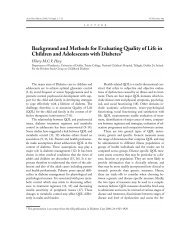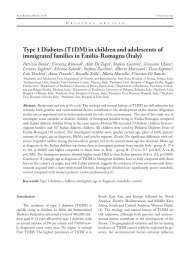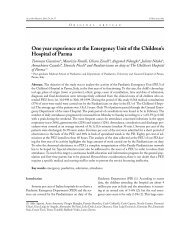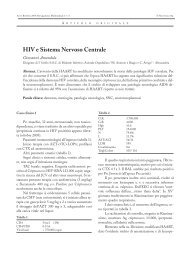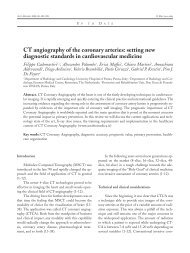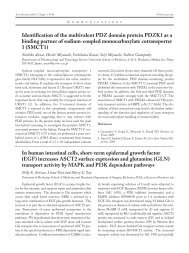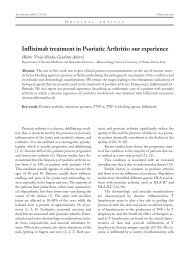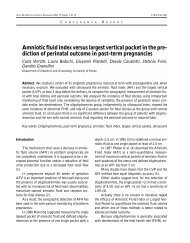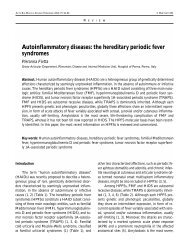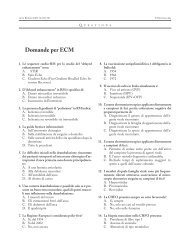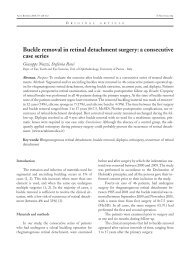Contribution of studies on renal effects of heavy metals and selected ...
Contribution of studies on renal effects of heavy metals and selected ...
Contribution of studies on renal effects of heavy metals and selected ...
Create successful ePaper yourself
Turn your PDF publications into a flip-book with our unique Google optimized e-Paper software.
60 I. Franchini, R. Alinovi, E. Bergamaschi, A. Mutti<br />
Biomarkers <str<strong>on</strong>g>of</str<strong>on</strong>g> effect<br />
A biomarker <str<strong>on</strong>g>of</str<strong>on</strong>g> effect has been defined as “a measurable<br />
biochemical, physiological or other alterati<strong>on</strong><br />
within an organism that, depending <strong>on</strong> magnitude,<br />
can be recognised as an established or potential health<br />
impairment or disease” (10). Such biomarkers are expected<br />
to reflect early modificati<strong>on</strong>s preceding progressive<br />
structural or functi<strong>on</strong>al damage at the molecular,<br />
cellular <strong>and</strong> tissue level. Therefore, they should<br />
identify early <strong>and</strong> reversible biochemical events that<br />
may also be predictive <str<strong>on</strong>g>of</str<strong>on</strong>g> later resp<strong>on</strong>se (11). Unfortunately,<br />
the mechanism <str<strong>on</strong>g>of</str<strong>on</strong>g> acti<strong>on</strong> <str<strong>on</strong>g>of</str<strong>on</strong>g> many chemicals is<br />
still unknown. Changes occurring in target tissues or<br />
cells may not be mirrored by biochemical changes occurring<br />
in peripheral, accessible media. Finally, whereas<br />
early damage may be repaired <strong>and</strong> subsequent dysfuncti<strong>on</strong><br />
compensated for, it may also trigger a “cascade<br />
<str<strong>on</strong>g>of</str<strong>on</strong>g> events” eventually leading to clinical disease<br />
(2, 11).<br />
Three main strategies have been followed in developing<br />
biomarkers <str<strong>on</strong>g>of</str<strong>on</strong>g> effect: (i) epidemiological; (ii)<br />
clinical; (iii) experimental. Most biomarkers <str<strong>on</strong>g>of</str<strong>on</strong>g><br />
nephrotoxicity have been identified <strong>on</strong> the basis <str<strong>on</strong>g>of</str<strong>on</strong>g><br />
pathophysiological reas<strong>on</strong>ing, starting from clinical<br />
c<strong>on</strong>diti<strong>on</strong>s, <strong>and</strong> extrapolating backward changes supposed<br />
to precede illness. Such an assumpti<strong>on</strong>, together<br />
with different methodological c<strong>on</strong>texts <str<strong>on</strong>g>of</str<strong>on</strong>g> applicati<strong>on</strong>,<br />
may lead to misinterpretati<strong>on</strong> <str<strong>on</strong>g>of</str<strong>on</strong>g> the health significance<br />
<str<strong>on</strong>g>of</str<strong>on</strong>g> observed changes, which greatly depends <strong>on</strong> the<br />
prevalence <str<strong>on</strong>g>of</str<strong>on</strong>g> the c<strong>on</strong>diti<strong>on</strong> being examined (12).<br />
Biomarkers <str<strong>on</strong>g>of</str<strong>on</strong>g> <strong>renal</strong> changes<br />
Work <strong>on</strong> biomarkers <str<strong>on</strong>g>of</str<strong>on</strong>g> nephrotoxicity dates back<br />
to the mid-twentieth century, when Friberg’s pi<strong>on</strong>eering<br />
<str<strong>on</strong>g>studies</str<strong>on</strong>g> <strong>on</strong> cadmium nephrotoxicity lead to the setup<br />
<str<strong>on</strong>g>of</str<strong>on</strong>g> a qualitative test identifying low molecular<br />
weight proteinuria (13). It took 15 years to develop semi-quantitative<br />
methods to assess cadmium-induced<br />
low-molecular weight proteinuria (14-16) <strong>and</strong> 15<br />
years more to characterize cadmium-induced proteinuria<br />
<strong>on</strong> the basis <str<strong>on</strong>g>of</str<strong>on</strong>g> the urinary excreti<strong>on</strong> <str<strong>on</strong>g>of</str<strong>on</strong>g> single low<br />
<strong>and</strong> high molecular weight serum proteins <strong>and</strong> enzymes<br />
(17). Immunochemical methods available by<br />
the early 1980s lead to the identificati<strong>on</strong> <str<strong>on</strong>g>of</str<strong>on</strong>g> kidneyderived<br />
antigens as early markers indicating that tubular<br />
cell damage <strong>and</strong> not simply dysfuncti<strong>on</strong> was associated<br />
with chr<strong>on</strong>ic exposure to cadmium (18, 19).<br />
Am<strong>on</strong>g several biomarkers available, a core battery <str<strong>on</strong>g>of</str<strong>on</strong>g><br />
urinary markers has been recommended, including albumin,<br />
<strong>on</strong>e low-molecular weight protein, such as β 2 -<br />
microglobulin or retinol-binding protein (RBP) <strong>and</strong><br />
<strong>on</strong>e marker <str<strong>on</strong>g>of</str<strong>on</strong>g> cytolysis, such as the activity <str<strong>on</strong>g>of</str<strong>on</strong>g> the lysosomal<br />
enzyme NAG (N-acetyl-β-D-glucosaminidase)<br />
(20). Small deviati<strong>on</strong>s falling within the 95 th -99 th percentile<br />
<str<strong>on</strong>g>of</str<strong>on</strong>g> reference values cannot be interpreted at the<br />
individual level, since alternative explanati<strong>on</strong>s are possible<br />
(21). When such markers are examined <strong>on</strong> a<br />
group basis, in the c<strong>on</strong>text <str<strong>on</strong>g>of</str<strong>on</strong>g> epidemiological <str<strong>on</strong>g>studies</str<strong>on</strong>g>,<br />
potential c<strong>on</strong>founding factors (e.g. meat meal, physical<br />
workload) should be also c<strong>on</strong>sidered.<br />
Toxic nephropathies from <strong>selected</strong> chemicals at workplace<br />
Recognized occupati<strong>on</strong>al <strong>renal</strong> diseases include<br />
those arising from exposure to <strong>heavy</strong> <strong>metals</strong>, organic<br />
chemicals (aliphatic <strong>and</strong> aromatic solvents <strong>and</strong> halogenated<br />
hydrocarb<strong>on</strong>s) <strong>and</strong> silica. Cause <strong>and</strong> effect are<br />
relatively easy to dem<strong>on</strong>strate when <strong>renal</strong> damage is<br />
acute, whereas establishing the c<strong>on</strong>tributi<strong>on</strong> <str<strong>on</strong>g>of</str<strong>on</strong>g> an occupati<strong>on</strong>al<br />
xenobiotic to kidney disease is c<strong>on</strong>siderably<br />
more difficult if the toxicity is delayed. The identificati<strong>on</strong><br />
<str<strong>on</strong>g>of</str<strong>on</strong>g> toxic compounds resp<strong>on</strong>sible for the progressi<strong>on</strong><br />
<str<strong>on</strong>g>of</str<strong>on</strong>g> chr<strong>on</strong>ic nephropathies was thought crucial in<br />
terms <str<strong>on</strong>g>of</str<strong>on</strong>g> preventi<strong>on</strong>, since the affected workers can be<br />
removed from the exposure, allowing to slow, if not to<br />
stop, the degenerative cascade leading to chr<strong>on</strong>ic <strong>renal</strong><br />
failure.<br />
Heavy Metals<br />
More than 45 naturally occurring elements are<br />
classified as <strong>heavy</strong> <strong>metals</strong>; am<strong>on</strong>g these, seven are generally<br />
recognized as nephrotoxic elements: lead, cadmium,<br />
mercury, uranium, chromium, copper, <strong>and</strong> arsenic,<br />
though chr<strong>on</strong>ic <strong>renal</strong> failure has been described<br />
for <strong>on</strong>ly lead, mercury, cadmium, uranium, <strong>and</strong> arsenic.<br />
Therapeutic use <str<strong>on</strong>g>of</str<strong>on</strong>g> cisplatin, gold, lithium, <strong>and</strong>



